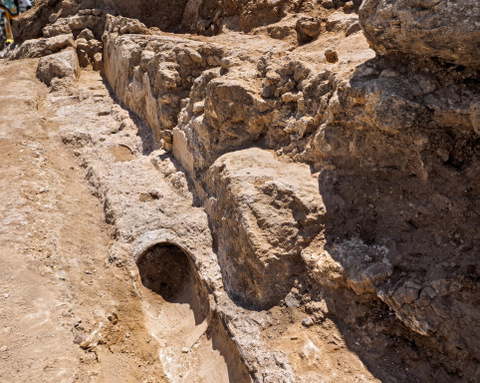As reported by Israel Antiquities Authority, May 2015:
A section of Jerusalem’s Lower Aqueduct, which conveyed water to the city more than 2,000 years ago, was exposed in the Umm Tuba quarter (near Har Homa) during the construction of a sewer line in the neighborhood by the Gihon Company. This line is just part of an extensive project directed by Zohar Yinon, CEO of the Gihon Company Ltd, to install a modern sewer system for the benefit of the residents of Umm Tuba and Sur Bahar.
The Israel Antiquities Authority conducted an archaeological excavation there following the discovery of the aqueduct. According to Ya’akov Billig, the excavation director, “The Lower Aqueduct to Jerusalem, which the Hasmonean kings constructed more than two thousand years ago in order to provide water to Jerusalem, operated intermittently until about one hundred years ago. The aqueduct begins at the ‘En ‘Eitam spring, near Solomon’s Pools south of Bethlehem, and is approximately 21 kilometers long. Despite its length, it flows along a very gentle downward slope whereby the water level falls just one meter per kilometer of distance. At first, the water was conveyed inside an open channel and about 500 years ago, during the Ottoman period, a terra cotta pipe was installed inside the channel in order to better protect the water”.
The aqueduct’s route was built in open areas in the past, but with the expansion of Jerusalem in the modern era, it now runs through a number of neighborhoods: Umm Tuba, Sur Bahar, East Talpiot and Abu Tor. Since this is one of Jerusalem’s principal sources of water, the city’s rulers took care to preserve it for some two thousand years, until it was replaced about a century ago by a modern electrically operated system. Due to its historical and archaeological importance, the Israel Antiquities Authority is taking steps to prevent any damage to the aqueduct, and is working to expose sections of its remains, study them and make them accessible to the general public.
The Umm Tuba section of the aqueduct was documented, studied, and covered up again for the sake of future generations. Other sections of the long aqueduct have been conserved for the public in the Armon Ha-Natziv tunnels, on the Sherover promenade, around the Sultan's Pool and additional projects are planned whose themes include the Lower Aqueduct.
The Israel Antiquities Authority noted favorably the professional attitude and thorough efforts on the part of the Gihon Company regarding the excavation and discovery of antiquities.






































Thanks for these past two reports - I'm always fascinated with such finds. When I was a teenager, I wanted to be an archaeologist. History is still my favorite subject to study -- after theology.
ReplyDelete